Google Analytics reports on traffic from many social networks. However, there is no way to distinguish among visitors who click on links in your profile bio, your status updates, or your ads. (And you have to look in your referrals to find out about networks that aren’t measured by Google Analytics.) In this post, we’re going to discuss how and where to use UTM parameters to measure what’s really effective in your social media marketing strategy.
We’ll also go over some new ways to link to your website using social media.
How to Set up Links with UTM Parameters
Adding UTM Parameters to a URL is easy. Just use the URL builder in the Google Analytics Help Center. For example, let’s say you want to track a URL in a specific social media profile. You would fill out the URL builder like this:
And it will give you this result:

You can use the following parameters in your URL to distinguish traffic:
- Campaign Source (required) – Used to identify the traffic source, such as Google, LinkedIn, etc.
- Campaign Medium (required) – Used to identify a medium like email, cost per click, etc.
- Campaign Term – Mostly used for paid search, such as the targeted keyword for an ad campaign.
- Campaign Content – Used to identify the format of your campaign, such as a text link, logo link, etc.
- Campaign Name (required) – Used to identify your campaign, such as your website, a specific sale, etc.
The parameters you use boil down to how you want to see them in your Google Analytics. When you look for them, you’ll go to Traffic Sources > Sources > Campaigns. First, you will see the listing for campaign names:
When you click on a campaign, you’ll see the source / medium:
Then, you have to then dig into the secondary dimensions to get to the campaign term and content. So, assuming you’re not working with AdWords, you may want to fit your details into the three required parameters for easy reporting.
Also, keep in mind that UTM parameters are sensitive to case. So, if you use Google in one parameter, and google in another, they will be tracked differently. In general, you’ll want to make sure you are using the same parameters for consistency and tracking, especially when it comes to the campaign name. You don’t want to have to look in two separate areas for the same campaign, such as Website and website or Spring Sale and springsale. Figure out a format and stick with it.
How to Add URLs with UTM Parameters to Your Social Profiles
The drawback to URLs with UTM parameters is their length. There are only two ways to add URLs with UTM parameters to your social profiles without having a ridiculously long link displayed. The first is to look for places where the social profile will display anchor text as opposed to the full URL. The second is to look for places where you can use a Bitly (or similar) shortened URL.
When using a shortened URL like Bitly, there are two key considerations: whether you want to have a branded URL in certain places where the full URL is displayed and whether people will think the link is suspicious because it is shortened. In the next section, we’ll discuss what types of links you can use and where.
Where to Use UTM Parameters
Now, let’s learn where you can use UTM parameters with your URLs on social media to analyze your social media referral traffic.
On Twitter, you can share links in four ways:
- In the 160 characters of your profile bio / description
- In the website field
- In a regular tweet
- In a promoted tweet
Most people are used to Bitly and other shortened links that use as few characters as possible, which means you can shorten your URLs with UTM parameters in most places.
The only exception is the main website link on your profile. Since it displays the first part of the URL that you enter, it will show part of the UTM parameters tags. For branding purposes, you will want to use your real URL instead of your Bitly URL. So, this might be one to skip for tracking.
Example UTM parameter strings to use are the following:
?utm_source=twitter&utm_medium=profile&utm_campaign=website
?utm_source=twitter&utm_medium=tweet&utm_campaign=website
?utm_source=twitter&utm_medium=promotedtweet&utm_campaign=website
On Facebook, you can share your URL in a variety of places:
- In your personal profile’s contact information
- In a status update on your personal profile
- In your page’s short description that displays below your page’s profile image
- In a post on your page’s wall
- In a promoted post on your page’s wall
- In a group description
- In a post within the group
The only acceptable place to use shortened URLs to shrink your URLs with UTM parameters is within posts. Your personal profile’s contact information, page’s short description, and group description show the full URL, so it’s best to use your normal URL. This is especially true on your page’s short description, as anything longer than 160 characters will be cut off.
Example UTM parameter strings to use are the following:
?utm_source=facebook&utm_medium=profilepost&utm_campaign=website
?utm_source=facebook&utm_medium=pagepost&utm_campaign=website
?utm_source=facebook&utm_medium=promotedpagepost&utm_campaign=website
?utm_source=facebook&utm_medium=grouppost&utm_campaign=website
There are several ways to share a link on LinkedIn. In fact, it probably has the most places to share links:
- In your professional profile’s contact information
- In your professional profile’s Publications and Projects sections
- In a status update on your professional profile
- In a status update in a group
- In a welcome message or announcement email to group members
- In your company page’s overview section
- In your company page’s product and services section
- In a status update on your company page
Unfortunately, the only UTM trackable areas are on your professional profile. When it comes to the status updates, LinkedIn seems to strip UTM tags, regardless of whether you shorten your URLs or not. And the rest display the full URL, which means you have to either share a shortened URL or the full URL with the UTM tags.
Example UTM parameter strings to use are the following:
?utm_source=linkedin&utm_medium=profilecontact&utm_campaign=website
?utm_source=linkedin&utm_medium=profilepublications&utm_campaign=website
?utm_source=linkedin&utm_medium=profileprojects&utm_campaign=website
Google+
Google+ is another network that has a lot of linking opportunities. Here they are:
- In your personal profile’s introduction
- In your personal profile’s links section
- In a status update on your personal profile
- In your page’s introduction
- In your page’s links section
- In a status update on your page
- In your community’s description
- In a status update on a community
With exception to the contributor links in your personal profile and the main website link on your page, the rest of the links on Google+ either use anchor text (profile, page, and community introduction and descriptions) or shortened URLs (status updates).
Example UTM parameter strings to use are the following:
?utm_source=googleplus&utm_medium=profileintroduction&utm_campaign=website
?utm_source=googleplus&utm_medium=profilelinks&utm_campaign=website
?utm_source=googleplus&utm_medium=profileupdate&utm_campaign=website
?utm_source=googleplus&utm_medium=pageintroduction&utm_campaign=website
?utm_source=googleplus&utm_medium=pagelinks&utm_campaign=website
?utm_source=googleplus&utm_medium=pageupdate&utm_campaign=website
?utm_source=googleplus&utm_medium=communitydescription&utm_campaign=website
?utm_source=googleplus&utm_medium=communityupdate&utm_campaign=website
Unfortunately, Pinterest has two issues when you’re trying to track your links. If you include a URL with UTM parameters, Pinterest will strip any parameters beyond the campaign source. And if you try to use a Bitly link, it will warn those who click on it that the link is suspicious and may block the referral altogether. For the most part, this is to prevent people from sharing affiliate links on their pins and profiles, but it hurts those trying to get specific with their tracking.
Niche Networks
Anything outside of the main social networks is not tracked in the Google Analytics social report. So you definitely will want to use UTM parameters when possible with those unless you want to hunt for them in your referrals section. Use the above examples to formulate your own UTM parameters and just change the source to match the network’s name.
How to Get the Results
As mentioned above, to see the results of your UTM parameter tracking, go to Traffic Sources > Sources > Campaigns. You also can use the custom reports section to create a report showing if your tracked campaigns result in goal completions. For example, you can set up a report similar to this:
You’ll be able to click on any of your campaigns to quickly see the main goal completions:
In Conclusion…
UTM parameters can be a powerful way to track where your social clicks are really coming from and which ones specifically are leading to qualified traffic and conversions. Just be sure to test your links to see if the UTM parameters are carried through the network referrals and not stripped (like on Pinterest) and that your URL’s UTM parameters aren’t showing (like on the Twitter website link).
Do you use UTM parameters to track social profile and status update clicks? What have you learned? Please share in the comments!
About the Author: Kristi Hines is a freelance writer, professional blogger, and social media enthusiast.
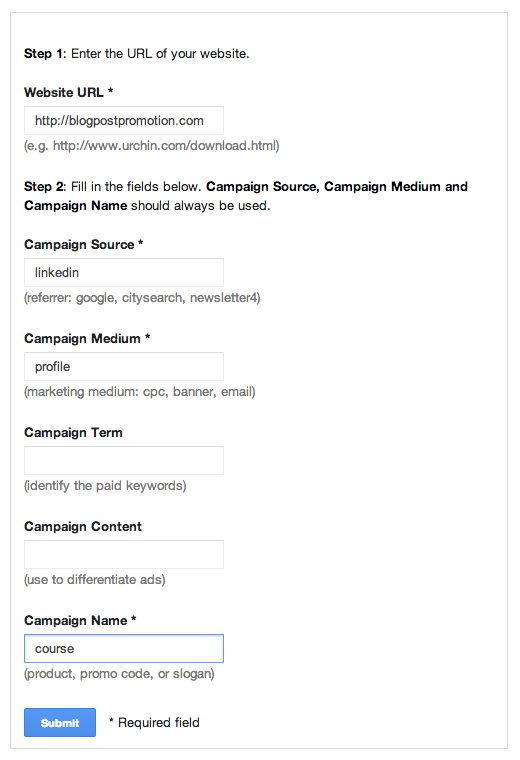
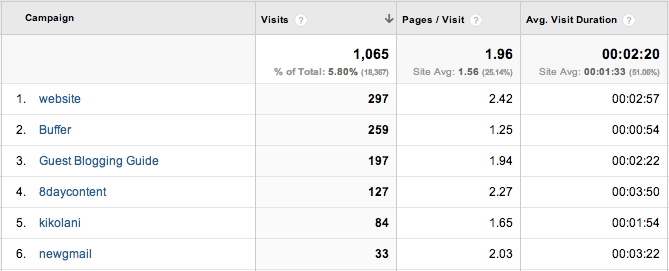
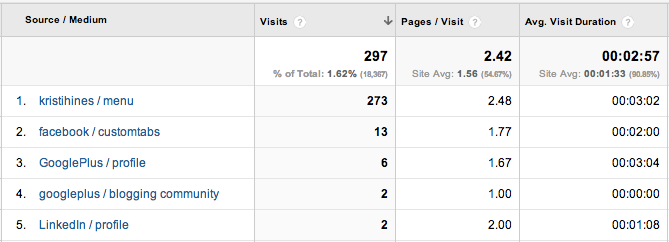
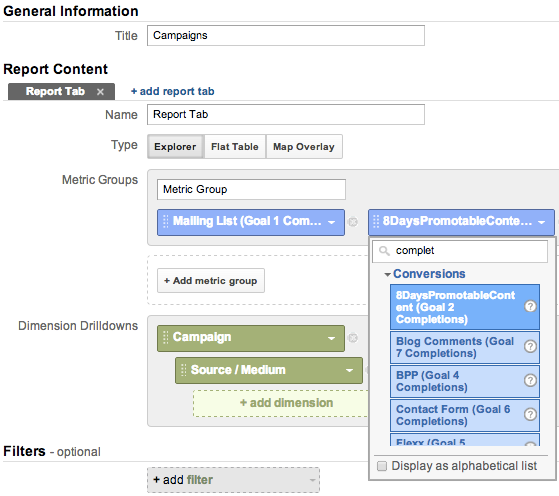
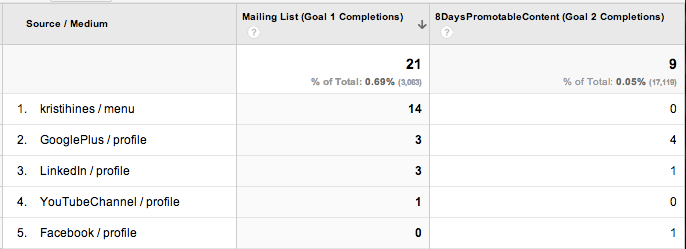
Comments (22)